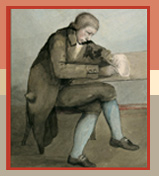Caerfyrddin
Yng Nghaerfyrddin ym 1819 y cynhaliwyd yr eisteddfod daleithiol gyntaf, a hynny dan nawdd y Cymdeithasau Cymroaidd a'r Esgob Thomas Burgess, esgob Tyddewi rhwng 1803 a 1825. Y mae Elijah Waring, yn ei gyfrol o atgofion am Iolo, Recollections and Anecdotes of Edward Williams (1850), yn adrodd yr hanes, yn union fel y clywsai ef gan Iolo. Cynhaliwyd y ddefod orseddol yng ngwesty'r Llwyn Iorwg yn y dref (gweler disgrifiad Waring isod). Yr oedd hyn yn drobwynt yn hanes yr Orsedd gan mai dyma'r tro cyntaf iddi gael ei chysylltu â'r eisteddfod. Trwy gyfrwng y cysylltiad hwn â'r mudiad eisteddfodol enillodd yr Orsedd gryn boblogrwydd a pharchusrwydd.
Yr oedd y lleoliad yng Nghaerfyrddin yn bwysig i Iolo oherwydd cysylltiadau hanesyddol – gwirioneddol a rhithiol – y dref â'r traddodiad barddol Cymraeg. Adwaenid y dalaith fel talaith Dinefwr gan feirdd canoloesol Cymru, ond gan mai yng Nghaerfyrddin tua 1453 y cynhaliwyd un o eisteddfodau amlycaf y traddodiad barddol dilys, daeth y dref yn rhan allweddol o stori farddol Iolo.
I Iolo, felly, golygai'r lleoliad pwysig hwn fod cylch hanes yn gyfan a chyfeiriodd at yr eisteddfod ganoloesol enwog yn y cyhoeddiad a wnaed gan y beirdd:
Ac yn yr Eisteddvod hon ... barnwyd yn unvryd unllais, heb nâg na gwrtheb na llaw na thavawd, bod y Rheithiadau Cerdd a vreiniwyd yn Eisteddfod Caer Vyrddin yn y vl. 1451, dan enw y pedwar mesur ar hugain, yn cyvyngu awen y Bardd o fewn llyffetheiriau rhy gaethion; a bod, yn rhy vynych o yr achaws, synwyr a rhwyddineb iaith yn cael eu hof[f]rwm ar allawr gwag-orchest egwanbwyll a diansawdd. (Yr Ymofynydd, V (1852), 272)
Dyrchafodd Iolo arwyddocâd hanesyddol yr achlysur yn yr araith a draddododd yng Nghaerfyrddin hefyd:
At a period when a dark cloud had involved us in a winter night of ignorance, Caermarthen had the highly merited honour of being as it were a morning star preceding the dawn of a glorious Morning that soon afterwards appeared. Some clouds have since appearaed, but again at Caermarthen the sky clears up we see the clouds beginning to disperse, and we hope that a glorious Summers day of Bardic and of every other description of Literature morality virtue and Religion will ensue the views and intentions of this Cambrian Society under the high patronage of our present worthy Lord Bishop of St. David's. ( NLW 21430E, no. 15)
Yng ngwesty'r Llwyn Iorwg gwelir ffenestr o wydr lliw gan John Petts sy'n coffáu Gorsedd arwyddocaol 1819 ac Eisteddfod Genedlaethol Caerfyrddin 1974.
Disgrifiad Elijah Waring o gyfarfod gorseddol gwesty'r Llwyn Iorwg, Caerfyrddin 1819:
THE B.B.D. affixed to the name IOLO MORGANWG, is an initial contraction of the style and title of his order: Bardd wrth fraint a Defod Beirdd ynys Prydain; in English, 'Bard, according to the rights and institutes of the Bards of the Island of Britain'. The grounds of this style and title are stated in the Institutional Triades (Trïoedd Braint a Defod) to be, because Bardism originated in Britain, was never well understood in any other country, and can only be preserved in its purity by means of the Voice conventional of the British Bards. The best authorities agree that Bardism is not an arbitrary system, or device of recent date: its institutions are unquestionably of very remote antiquity; and not only Iolo Morganwg, but many other learned Welsh antiquaries, assert that the constitutional principles, and ritual of the order, have been preserved unimpaired. It may be doubted whether any man of the age had more diligently studied these institutes, than our Glamorganshire Bard; and when he attended the Eisteddfod at Carmarthen in 1820 (sic), he deeply interested the learned Bishop of St. David's (Dr. Burgess) by his eloquent expositions of them. The ceremonial used in admitting several candidates for Bardic degrees, on that occasion, was described by an eye-witness as very impressive; and the BARDD BRAINT [Iolo Morganwg] maintained the dignity of his Order with absolute authority, standing in the midst of a circle of stones on the Maen Gorsedd, or Stone of Covenant, from whence he commanded the several aspirants to put off their shoes, before entering the circle; after which they approached him, one by one, and received the symbols of the institution at his hands. The good Bishop was present, and wished the Bard to dispense with some of the initiatory forms; but he would not permit the slightest departure from ancient usage, for within that circle he was, and would be, Pontifex Maximus, and beyond his authority there was no appeal. (Recollections and Anecdotes of Edward Williams, pp. 52-3)



